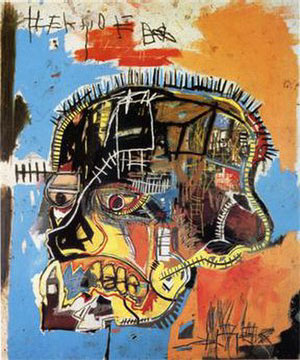An original painting by Jean-Michel Basquiat from 1981-1983, regarded as his “peak” period, can sell for up to $16 million. No– wait: $29 million.
Basquiat made some money from his own work but artists themselves almost never make the really big money, for two reasons. Firstly, works of art don’t sell for all that much until the artist is dead. Secondly, art is a racket. By “racket”, I mean that nobody really knows what the “value” of a work of art is until the institutional forces that manage, manipulate, and arrange the art world take hold of it. Basquiat is definitely safely dead, and his works are distinctive, so the art world can now play it’s role. He must be desired to be desired, wanted to be begged, and rare enough to be valuable. But Basquiat’s works will never be as rare as collectors think because it is in no one’s interest to promote the idea that there are a lot of Basquiats out there. [I just heard that someone living in a flooded area of Calgary had an original Van Gogh painting in his house.]

There was, for a time, something called the “Authentication Committee”. You see, a Basquiat is not valuable to anyone because of what it looks like, in spite of utter drivel you will hear:
“he painted a calculated incoherence, calibrating the mystery of what such apparently meaning-laden pictures might ultimately mean” (Marc Mayer, Basquiat in History).
Basquiat’s paintings are very, very valuable because they, like all other collected art, have become a form of currency. They might as well be currency. Above is a $7 million bill. If you really think you could paint it, you ought to give it a try. I can guarantee you can’t.
I was going to write something snarky about rich people who don’t appreciate real art and only collect it as an investment, and for it’s snob value. That’s probably all true, but there’s not much new to say about it. I was just struck by the idea of an “Authentication Committee”. We all need an Authentication Committee: this is real, this is not real. This is a hoax. This is phony. All of this is phony. Everything is phony. If everything is phony, then everything is real. You need to sort it out for yourself. You need to stand in front of the painting and decide whether or not you find it entertaining in some way. Then you need to decide if it is entertaining to you because it is shocking that people pay a lot of money for it, or because the colors and shapes and design tickle your eye. Or because other people think that it is only entertaining because it cost a lot of money but you are smarter than that. Or because you can see why people pay a lot of money for it but you have no idea why this particular work, and not some other work by a completely unknown artist, is any good. All of our perceptions can be corrupted. All of them matter. None of them do. But then all of them do.
I like the painting. I think it’s original and interesting and expresses something about Basquiat’s desire to express something. I would be willing to pay more than $100 for that painting, if I ever get a chance to buy it.
I love this:
“It hung above a desk in a hotel suite where Coco Chanel lived for more than 30 years and was only discovered to be important last summer, when the hotel shut for a 27-month renovation in the face of stiff competition from newer hotels. ‘It is a magical discovery,’ said Cecile Bernard, a Christie’s expert…'”
The magic, of course, is the fact that this painting was not “important” until an expert from Christie’s got onto her solemn podium of high art and pronounced it so.
The painting is “Le Sacrafice de Polyxene” by Charles Le Brun from the 17th century. It is worth about $650,000.00 (U.S.).
Here’s more on “authentication” and why the art of authentication is in crisis.
And from that article:
When the museum sent Pivar a 15-page letter in 2021 explaining why it did not deem the painting he had spent a few thousand dollars on at auction a van Gogh, he responded by suing for $300 million in U.S. District Court. The museum’s failure to recognize the painting was “negligence,” he argued in court papers, and had reduced its value to almost nothing.
So Pivar is asking the court to step in, essentially, and rule that he has a legitimate Van Gogh, over the objections of the most authoritative body in the world on that subject.
